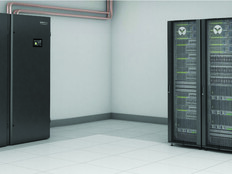What Is Data Center Infrastructure Management Technology?
Agency IT officials cannot figure out how to consolidate and optimize without knowing the equipment and data they have, the space and energy demands of that data, the potential security problems and the potential to apply new technology, Daniel Kent, CTO of U.S. public sector for Cisco Systems’ federal organization, a DCIM service provider to government agencies, previously told FedTech.
“We have to help them get from the legacy world to this new world,” he says. DCIM is an umbrella term that encompasses a wide range of tools that IT leaders can use to oversee, monitor and understand their data centers, from power consumption to data storage.
DCIM, as Gartner notes, lets agencies monitor, measure, manage or control the utilization and energy consumption of all IT-related equipment in a data center, like servers, as well as facility infrastructure components, like power distribution units.
“It has a heavy focus on monitoring what is being used in the data center,” Shawn McCarthy, research director for IDC Government Insights, previously told FedTech. “The end game is to collect some good, hard data from which to make decisions.”
DCIM software can provide IT administrators and managers with actionable intelligence about how their agencies’ data centers are performing, especially in terms of facilities infrastructure and power consumption, so that they can make decisions on how best to configure the data center to optimize performance.
MORE FROM FEDTECH: Find out how disaster recovery plans keep agencies’ data centers running.
How Does DCIM Play a Part in DCOI?
DCOI specifically calls for agencies to use DCIM technology. It notes that agencies should continue to “replace manual collection and reporting of operational data as well as systems, software, and hardware inventory housed within data centers with automated monitoring, inventory, and management tools (e.g. Data Center Infrastructure Management (DCIM).”
Those tools will need to be updated, the DCOI notes, to match the performance metrics it spells out. Those include metrics around virtualization (agencies are required to report “the number of servers and mainframes that are currently serving as hosts for virtualized or containerized systems in their agency-managed data centers”). Another metric deals with advanced energy metering, for which agencies are expected “to have advanced energy metering and sub-metering, sufficient to accurately estimate Power Usage Effectiveness (PUE), for all remaining data centers over 100 kW that they are planning to keep open.”
In terms of server utilization, DCOI says agencies “should use automated monitoring software to measure application usage to accurately determine needs, such as storage space, CPU, memory, and redundancy.”
“Any data center initiation, significant expansion, or migration project that received Development, Modernization, and Enhancement (DM&E) funds in fiscal year 2017 or later must implement automated monitoring and management tools,” the policy states.
However, according to DCOI, agencies are “strongly encouraged” to use automated monitoring and management tools throughout their data centers, especially those that use more than 100 kilowatts of power.
To the extent permissible under the Federal Acquisition Regulation, agencies “must include standard automated infrastructure management requirements for all new data center service contracts or procurement vehicles,” according to DCOI.
DCOI further states that any new data center contractor procurement vehicle needs to have provisions for the contractor to report to the agency “whether the contracted facility utilizes automated infrastructure management, except where such data is already reported directly to OMB” or General Services Administration through participation in a multiagency service program.
MORE FROM FEDTECH: Discover how HCI helps feds find new ways to store and analyze data.
DCIM Vendors to Explore
DCIM is an established technology toolset and agencies have a wide range of solutions from leading vendors that they can choose from to help automate data center monitoring.
Those include StruxureWare for Data Centers from APC by Schneider Electric, Vertiv’s Trellis platform and Power IQ DCIM Monitoring from Sunbird Software.
Todd Prieve, a CDW segment team leader and solution architect for data center power, cooling and DCIM, notes in a blog post that when picking DCIM vendors, agencies and other organizations first need to develop a list of DCIM requirements believed to be the best fit for the organization. That helps IT leaders prioritize which metrics and factors an agency needs to monitor.
“Rather than wasting time looking at demos of a variety of DCIM software products and listening to multiple vendor sales pitches on their DCIM solution, the first thing to do is to sit down and build out a requirements list,” Prieve says.
Pireve says that sorting out which DCIM software functions and features must be included and those that are not mandatory but would still add value will give IT leaders “a foundation of DCIM requirements to refer back to” and will “help guide you as to what solutions could be the most viable.”











